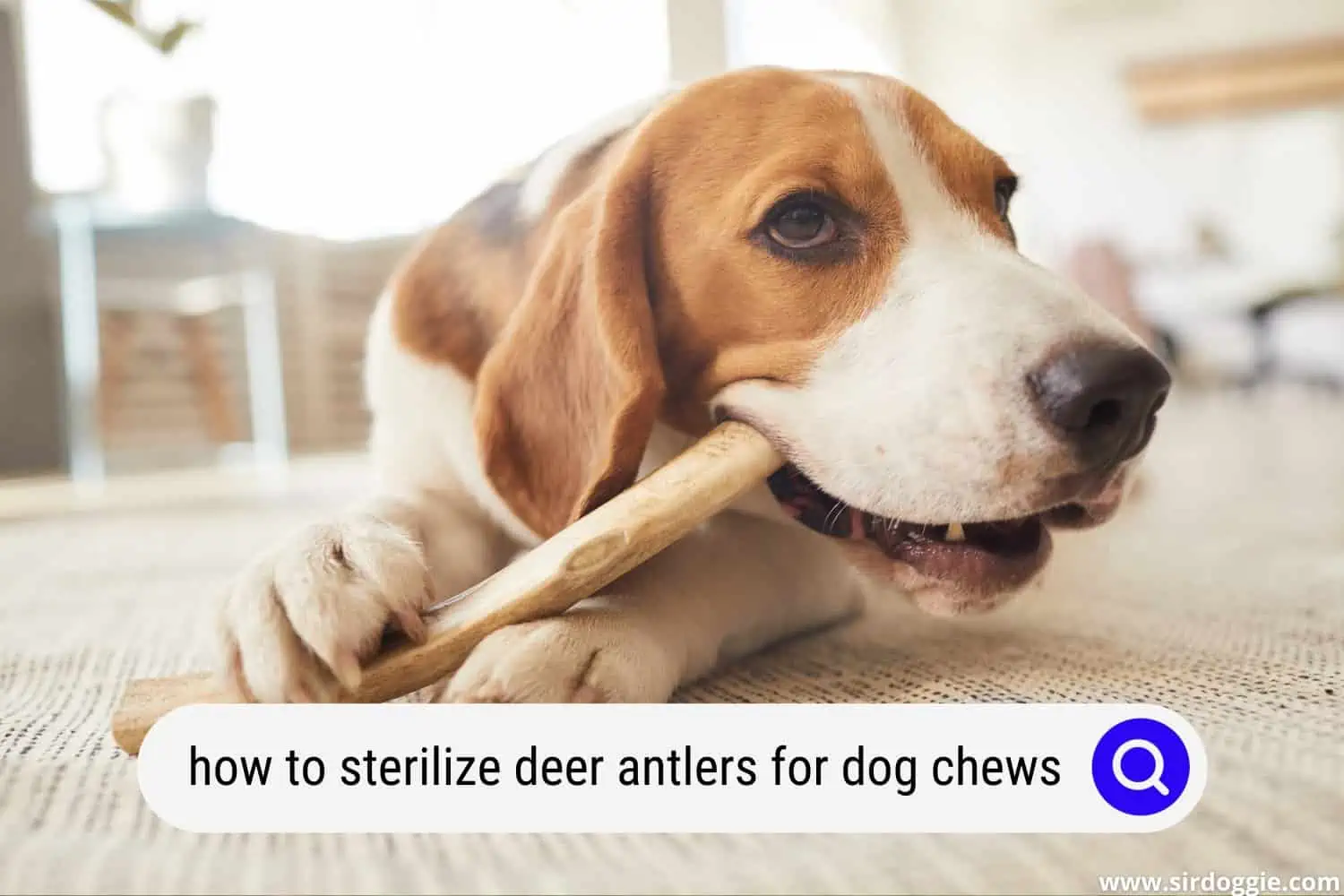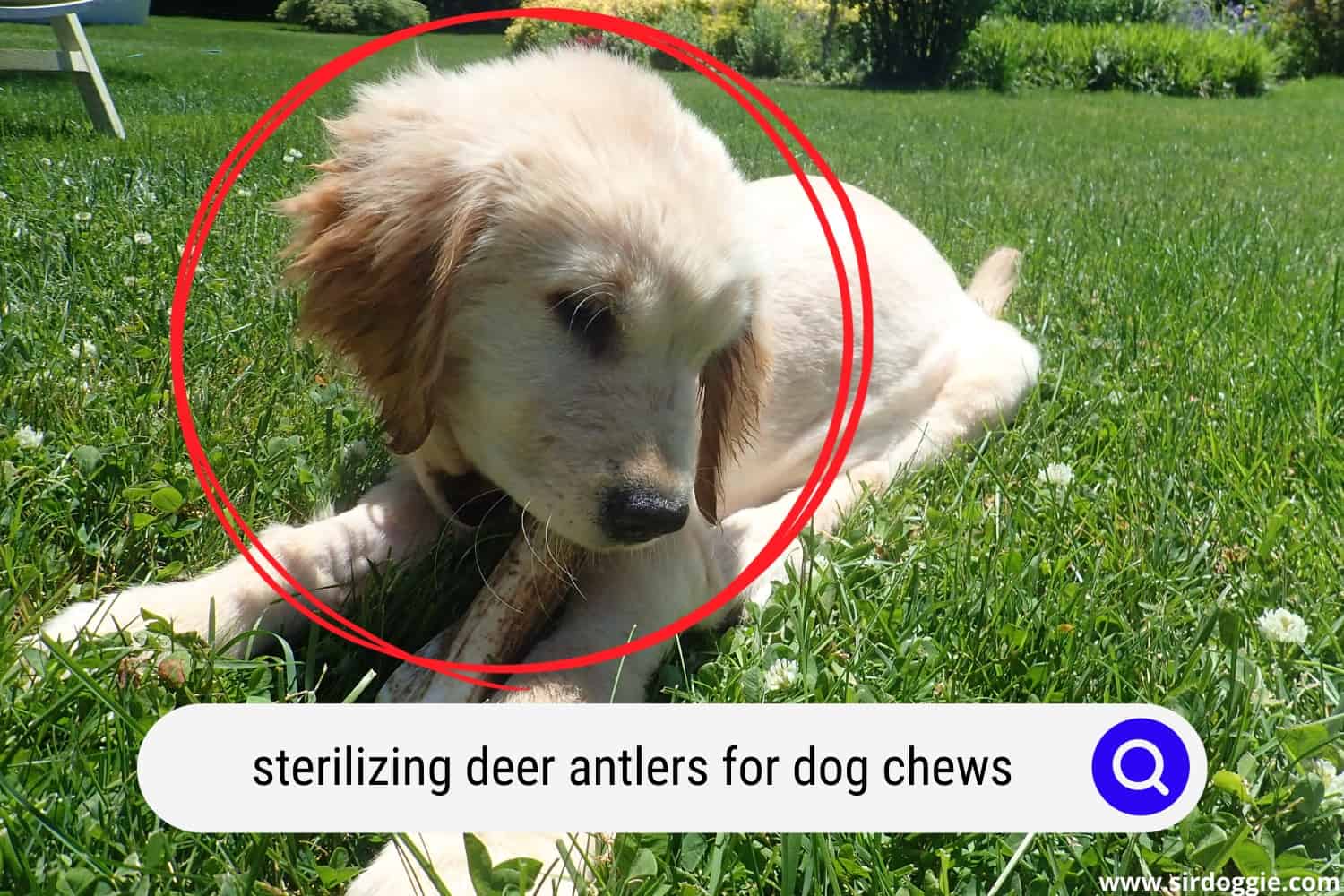How To Sterilize Deer Antlers for Dog Chews
Many dogs have a strong chewing instinct. As a dog owner, you want to use this instinct to help them burn off excess energy, get treats, and maintain their dental health and jaw strength. If you have an especially enthusiastic chewer, providing safe dog chews will also help save your shoes and furniture!

Dog owners with powerful chewers can spend a lot of money trying to find dog chews that don’t disappear quickly. Deer antlers are a great solution. They are strong, durable, and last for months at a time. They also don’t wreak havoc with your dog’s digestive system.
If you’re not experienced in giving antlers to your dog, you need to know how to sterilize deer antlers for use as dog chews. The best and easiest way to sterilize deer antlers is by blanching them. Blanching requires placing the chunk of antler in boiling water for one to two minutes and then immediately immersing it in cold water. Boiling antler chunks will sterilize them, but because antler is essentially bone, you risk becoming brittle. Brittle bones can splinter when your dog chews them and become a choking hazard.
If you’re not a hunter, don’t fret! Deer, elk, and even moose antlers can be purchased in most pet stores in pre-cut chunks perfect for dog chews. If you are a hunter or know one, making antlers into dog chews is a great way to use all the parts of the animal carcass, some of which would otherwise be thrown out.
There are a few ways to source deer antlers for dog chews, but it’s important to know how to properly sterilize and prepare the antlers to keep your dog safe from choking hazards and potential bacteria.
Are deer antlers actually good dog chews?
There are thousands of dog chew options available, from chew toys to bully sticks to rawhide bones. So, are deer antlers actually special? Are they safe? Why should you give them to your dog?
There are some benefits for your dog that are unique to deer antlers, especially if you have a strong chewer. Strong chewers can devour dental chews and bully sticks in under 30 minutes, whereas deer antlers last for months.
There are also some situations where using deer antlers as a dog chew is inappropriate, which we’ll discuss.
Where to get deer antlers for your dog
If you are a hunter or have a family member who hunts, this is the easiest and most obvious source of obtaining deer antlers. Antlers have to be removed from the deer before the meat can be processed, so re-purposing them makes use of a part of the deer carcass that would otherwise be disposed of.
If you don’t have a hunter available, try contacting a local butcher or wild game processor. If this makes your stomach turn, you can also try contacting wildlife sanctuaries for shed antlers or buy them on Amazon.
If you live in a region with deer, it’s tempting to pick up shed antlers off the ground. Don’t do this. It’s impossible to know how long the antler has been lying there or if it was shed from a healthy animal.
How to sterilize deer antlers for dog chews
Once you’ve sourced your antler, you need to take a few steps to ensure it is safe for your dog to chew on.
- Cut the antler down to an appropriate size. This can be done with a hacksaw but will be easier if you have access to some sort of power saw. 8 to 10 inches is usually an appropriate size for a dog chew. Make sure to wear eye protection while cutting in case any splinters come off the antler.
- Use a piece of sandpaper to sand down any rough edges left on the antler after cutting. Run your hands over the antler and smooth any pointy spots.
- Sterilize the bone by blanching it. If you simply boil the bone, you will get rid of any bacteria, but you risk it becoming brittle and a choking hazard for your dog. Blanching requires placing the antler in boiling water for a minute or two, then removing it and placing it in cold water.
If you choose, you can simmer the antler but don’t boil it. To do this, you want to bring the water to a low boil with small bubbles. Maintain the simmer for approximately 30 minutes, being careful not to boil the water.
Benefits of deer antler chews
Antler chews are all-natural dog treats that are chewed on by wild dog breeds like wolves or coyotes.
- Dental health – Managing a strong chewer’s dental health can be challenging for any dog owner. Dogs get plaque and tartar build-up on their teeth, and plenty of dogs won’t tolerate you brushing their teeth regularly. Deer antler chews can be a great supplement to clean your dog’s teeth. Because they are bone, antlers are a great source of calcium, which also supports good dental health. Unlike many other edible chews, they don’t upset your dog’s digestive system or trigger food allergies.
- Stronger than other bones – If you correctly prepare deer antlers, they don’t break apart under chewing stress the way many other bones do. Because they last so long, they are budget-friendly and provide stimulation for your dog for weeks or months on a single chew.
- Clean and odorless – Lots of other dog chews have strong odors associated with them and flavors that can stain your furniture or carpet. Antlers are neither. They are clean and completely devoid of smell.
- Environmentally friendly – If you are concerned about environmental sustainability, deer antlers are more sustainable than artificially made dog chews. The majority of antler chews you buy at the pet store come from naturally shed antlers. If you’re not a fan of hunting, this makes antlers an option for you, too. Deer, elk, and moose shed their antlers every year. The ones made into commercial dog chews are simply the old antlers they leave lying on the ground.
Problems with deer antler chews
- Not appropriate for dogs with sensitive teeth – Deer antlers are very hard. In fact, they are one of the toughest dog chews available, which makes them not appropriate for puppies with soft, growing teeth. Older dogs or dogs with dental problems risk tooth breakage with antlers. It’s important to make sure your dog has good dental health before giving them a deer antler chew.
- Not everything you buy is good quality – Antler chews that are not sustainably sourced or properly prepared are dangerous for dogs. Antlers that have been lying on the ground for extensive amounts of time become brittle and splinter when your dog chews on them. This makes them a choking hazard.
If antlers aren’t sterilized properly, they can be full of bacteria. Make sure any antlers you give to your dog are reputably sourced and fresh. If you look at a cross-section of the antler (on the cut end), multiple colors should be visible. If the antler is pure white, it has been bleached and shouldn’t be given to your dog.
- Cost – Deer antlers can be expensive to buy at pet stores. Because they last for months, it’s assumed that dog owners will owner buy two or three a year. If you have access to deer antlers, it is more cost-effective to source and prepare them on your own. This also gives you quality control over the antlers your dog chews on.
Alternatives to Deer Antlers
If you’re looking for an alternative to deer antlers for your aggressive chewer, there are several options.
- Dental chews – great for your dog’s teeth, not as long-lasting as deer antlers
- Knuckle bones – a very popular natural treat. They still require supervision, however, as they are more likely to splinter or break off in chunks during chewing.
- Cow hooves – similar to antlers, low calorie, but can splinter easily.
- Horns – a similar option to antlers but smaller
- Rawhide chews – a great option to keep your dog busy chewing. If your dog swallows his chews, they can cause digestive issues as rawhide does not digest in a dog’s stomach.
Nylabone makes a great bone antler alternative, available here.
It comes in two sizes, medium and large, and either chicken or venison flavors. It’s made of nylon, so it won’t splinter and cause a choking hazard. The textured surface provides the same dental benefits as antlers and satisfies the needs of dogs who like to chew.

Related Questions
Are whole or split antlers better for my dogs?
There is no difference between whole or split antlers for your dog as far as health benefits go. Your dog may take less time to consume a split antler because the bone marrow core is exposed, making it more appetizing and better tasting. Having said that, whole antlers will inevitably last longer because your dog has to chew down to the marrow.
Whichever you choose will depend on your dog. If your dog only chews for short periods of time, you may want to use split antlers, so they have a more satisfying experience. If you have a large breed dog that’s an aggressive chewer, you definitely want to give them a whole antler.
Does it matter whether I use elk antlers or deer antlers?
Deer antlers have a harder outer shell than elk antlers. Elk antlers are softer and, therefore, easier for dogs to grind down than deer antlers. Similarly, mule deer antlers are slightly softer than whitetail antlers, so they’re not as hard on your dog’s teeth.
There is also a difference in density in different parts of the antler. The upper part of antlers is softer and easier to chew than antler bases.
Whether you choose deer or elk, and which part you choose to give your dog will depend on the status of their dental health and how aggressive of a chewer they are.
Are antlers safe for puppies?
There is a lot of conflicting information on whether antlers are safe for puppies, but as a general rule, the answer is no. Puppy teeth are just developing and are softer and break more easily than adult teeth. Antlers have the potential to break your puppy’s teeth and cause injuries to their soft palate.
It’s best to wait until your dog has all their grown-up teeth before giving them an antler chew.

Family Dog Expert Author
Hi there! I’m Stuart, a devoted dog lover and family dog expert with over a decade of experience working with our furry companions. My passion for dogs drives me to share my knowledge and expertise, helping families build strong, loving bonds with their four-legged friends. When I’m not writing for SirDoggie, you’ll find me hiking, playing with my beautiful dog, or studying music.